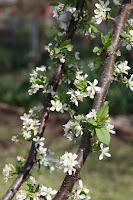Henbit is Blooming Everywhere!

Wherever you drive now, you see patches of Henbit’s lavender and purple flowers on purple stems. Henbit can be confused with Purple Dead Nettle (Lamium purpureum) though Henbit has heart-shaped leaves and Purple Dead Nettle has triangle shaped leaves that cluster in clumps. Both are winter annuals that get their start in the fall, form a small rosette of leaves in the winter and then have those carpets of flowers in the spring. Seed formation follows and the plants die in the summer. Henbit leaves are high in iron, vitamins and fiber; it can be boiled, then cooked with butter, spices and a sour cream white sauce. Highly valued by foragers, Henbit and Dead Nettle are added to smoothies, cooked and eaten raw. Henbit is also eaten by some animals and can cause ‘staggers’ in sheep, horses and cattle. Henbit’s Latin name is Lamium amplexicaule, with amplexicaule meaning clasping, or, how the leaves clasp the stems. Lamium is from Lamia, a Greek mythology creature name as s...



